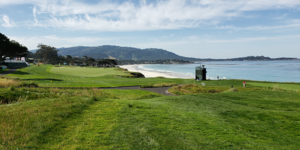Debunking a large patch myth
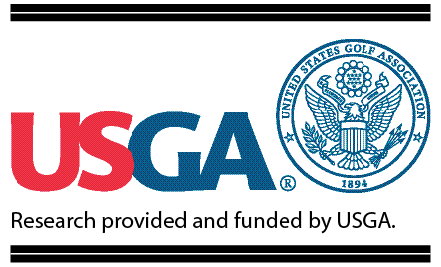 Meyer zoysiagrass (Zoysia japonica Steud.) is favored for use on golf course fairways and tees in the United States Transition Zone because of its excellent traffic durability, low maintenance requirements and cold hardiness. Although the species is relatively pest tolerant, large patch continues to be a limiting problem for maintaining aesthetics and playability.
Meyer zoysiagrass (Zoysia japonica Steud.) is favored for use on golf course fairways and tees in the United States Transition Zone because of its excellent traffic durability, low maintenance requirements and cold hardiness. Although the species is relatively pest tolerant, large patch continues to be a limiting problem for maintaining aesthetics and playability.
Large patch is caused by the pathogen Rhizoctonia solani AG 2-2 LP, and results in matted orange or brown patches ranging from 3 feet to 25 feet or more. Large patch symptoms appear during the slowest and weakest periods of growth, when zoysiagrass is either entering or exiting cold-weather dormancy in the cool, wet fall and spring months. In severe cases, the disease can leave patches or rings of completely killed turf that recover slowly and open the door for the invasion of weeds such as bermudagrass.
On sites with historically severe symptoms, large patch control currently requires two to four preventative fungicide applications split between the spring and fall months. To reduce the need for fungicide applications, superintendents should combine chemical applications with cultural management practices, including the reduction of leaf wetness and saturated conditions, raising mowing heights and avoiding aerating or verticutting during disease outbreaks to avoid spreading diseased plant material.
Large patch versus brown patch
Because brown patch and large patch are caused by members of Rhizoctonia solani, the common belief is that nitrogen applied during the large patch infection period increases large patch severity. Excessive summer nitrogen applications when brown patch is active has consistently been linked to increased disease severity on cool-season grasses. However, the brown patch and large patch pathogens have different and unique life cycles, and superintendents shouldn’t treat them similarly. The diseases are caused by different anastomosis groups of Rhizoctonia solani (AG 2-2 IIIB for brown patch, AG 2-2 LP for large patch) that cause symptoms on different hosts (cool-season versus warm-season) at different periods of time (summer versus spring and fall) and different plant parts (foliar versus lower crown and leaf sheaths). So, nitrogen management strategies for large patch may differ from those for brown patch.
Previous studies do not demonstrate a link between nitrogen applications and increased large patch incidence. Increased rates of summer-applied urea do not increase large patch severity, and though at this point in the growing season zoysia growth is at its peak, large patch symptoms are lacking and lower infection rates are presumed. A 2013 study found that a combined spring and fall urea application decreased large patch severity compared to summer urea applications at two of the three experimental sites, contrary to the belief that nitrogen applications during large patch activity increase large patch incidence.
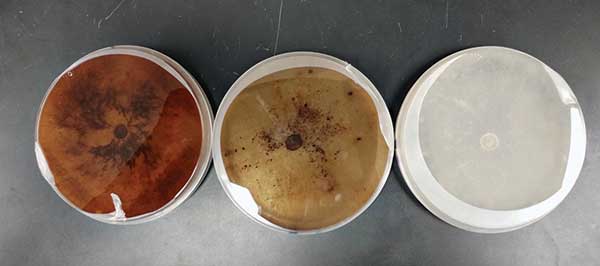
Figure 1 Morphology of Rhizoctonia solani AG 2-2 LP on potato dextrose agar (left), calcium nitrate-amended media (middle) and ammonium sulfate-amended media (right).
In addition to nitrogen application timing, nitrogen source has the potential for limiting disease. Most previous studies regarding N effect on large patch have focused on urea, which is attractive because of its high nitrogen ratio, quick release characteristic and low price point. Nitrogen sources such as ammonium sulfate [(NH4)2SO4] and calcium nitrate [Ca(NO3)2] have not been researched in depth for large patch control and may impact the pathogen’s environment in ways that are detrimental to pathogen survival and infection. For soil-borne diseases such as summer patch, plots treated with NH4-N had lower disease severity than those treated with NO3-N. In preliminary studies at the University of Missouri, the large patch pathogen R. solani AG 2-2 LP was grown on media containing urea, ammonium sulfate or calcium nitrate as its primary source of nitrogen (Figure 1). Typically, the pathogen produces the dark brown pigment melanin in culture. On potato dextrose agar and calcium nitrate-amended media, the pathogen produced melanin and turned brown. However, on ammonium sulfate-amended media, the culture was unable to produce melanin and remained white in color. A lack of melanin production in other plant pathogens restricts their ability to infect and cause disease in their plant hosts. Therefore, field applications of ammonium sulfate may serve as a tool to inhibit melanin formation in R. solani AG 2-2 LP and decrease large patch incidence. Nitrogen source and soil pH may have other direct or indirect effects on the fungus as well.
Nitrogen application approaches
These previous findings suggest the potential for developing a large patch management strategy with a specific nitrogen application scheme. In 2013-2015, a collaborative field study conducted by Kansas State University and the University of Missouri focused on pinpointing the best nitrogen application timing for limiting large patch incidence and determining the impact of nitrogen source on large patch severity. The trial was conducted concurrently at two locations in Manhattan, Kan. (Kansas State University) and in Columbia, Mo. (The University of Missouri). Treatments included ammonium sulfate, calcium nitrate or urea applied in spring or fall when soil temperatures at a 2-inch depth averaged 60 degrees F or 70 degrees F over a five-day period, and a standard summer nitrogen application schedule (Table 1). A follow-up — and ongoing — study at the University of Missouri combines several factors, including nitrogen application timing, nitrogen source and a single spring fungicide application in an effort to develop an integrated strategy for large patch management (Table 2).
Table 1
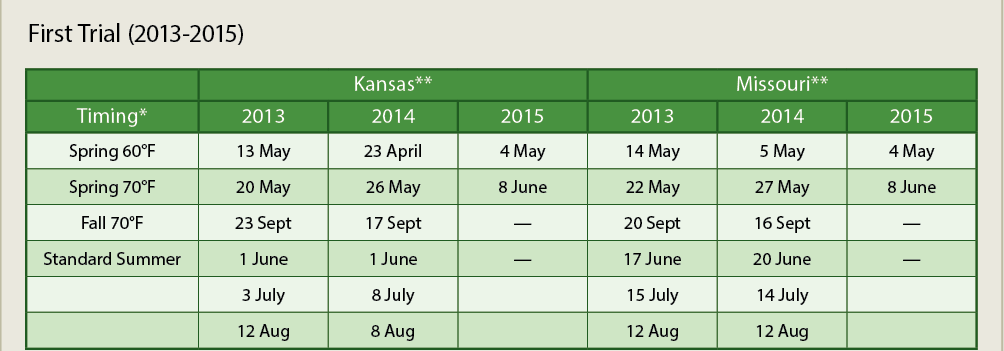
Application dates for fall, spring and standard summer fertilizer treatments for the first trial. Spring and fall nitrogen treatments were applied at a rate of 0.75 lbs. N/1,000 sq. ft. when the five-day average 2-inch soil temperature reached the target temperature. Dates for each application are listed for each year of the study. Spring and fall fertilized plots were supplemented with nitrogen applied in June, July and August to reach a total of 1.5 lbs. N/1,000 sq. ft. per year. Standard summer fertilized plots received 1.5 lbs. N from urea/1,000 sq. ft. per year split equally among applications.
*Plots initially receiving nitrogen in spring or fall in Kansas were supplemented in the summer with the same initial nitrogen source. Plots initially receiving nitrogen in spring and fall in Missouri were supplemented in the summer with urea.∂ƒ
Table 2
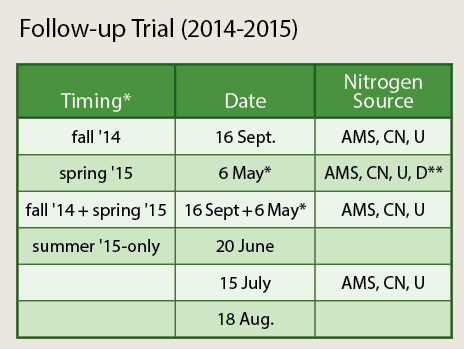
Application dates for fall, spring and summer fertilizer treatments of ammonium sulfate (AMS), calcium nitrate (CN), urea (U) or Duration (D) for the follow-up trial. All timings are based on a 65-degree F, five-day average soil temperature threshold measured at a 2-inch depth. All spring and fall applications of ammonium sulfate, calcium nitrate and urea recƒeived 0.5 lbs. N/1,000 sq. ft. on the listed date(s). All ammonium sulfate, calcium nitrate and urea plots received a total of 2.0 lbs. N/1,000 sq. ft. per year.
*Torque was applied once to duplicates of all plots on this date at a rate of
0.6 fl. oz./1,000 sq. ft.
**A singular application Duration CR 120-day was applied at a rate of
3 lbs. N/1,000 sq. ft.
No threat in spring or fall N
In both studies, nitrogen was applied just prior to or during visible large patch outbreaks in both the spring and fall. A previous mantra was that nitrogen applications made during the infection period would encourage lush leaf growth and predispose zoysia to more severe infection and symptom development. Another fear was that fall nitrogen applications would predispose zoysiagrass to winterkill. Results from both field studies do not demonstrate either assertion to be true.
No increase in large patch severity was observed with spring or fall nitrogen applications compared to summer applications in Kansas or Missouri. In addition, Missouri plots receiving a late spring nitrogen application (70 degrees F soil temperature threshold) had lower large patch severity and higher percent green cover compared with those receiving a standard summer program on several rating dates in 2014. This finding was not consistent with results at the Kansas location. The details of this study were published in the peer-reviewed scientific journal Crop, Forage, & Turfgrass Management.
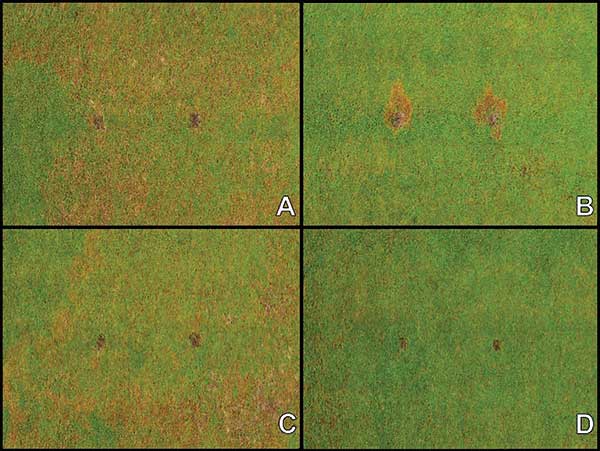
Figure 2 Large patch development on plots receiving nitrogen at different periods of time in Missouri: Summer (A), Spring (B), Fall (C), Fall plus Spring (D). No fungicide was applied to these plots.
The second follow-up study is yielding similar results regarding spring fertility applications. Plots without fungicide applications that received summer-only and fall nitrogen applications had greater large patch severity in the spring than those receiving spring or combined fall plus spring nitrogen applications (Figure 2). In fact, any plot receiving nitrogen applications in the spring without fungicide statistically had similar large patch severity compared with their identically fertilized plots treated with a single spring tebuconazole application (Figure 3). There were no interactions between fungicide applications and nitrogen timing. Plots receiving fall nitrogen applications in both trials had longer sustained green turf in the fall with no increase in fall large patch symptoms and no winterkill damage the following spring. These findings go against previous notions that nitrogen applications during large patch outbreaks increase disease severity and suggest that spring nitrogen applications may encourage zoysiagrass to outgrow large patch infection.
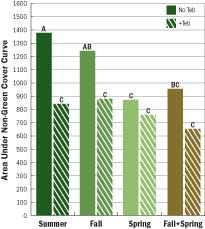
Area under non-green cover curve (AUNGCC) of all nitrogen timings with and without tebuconazole application in the follow-up trial at Missouri in 2015. AUNGCC is a single variable for total large patch during the spring disease season. Lower values indicate lower large patch severity.
Means were averaged across all nitrogen sources. Columns with the same letter do not significantly differ according to Fisher’s Protected LSD (P = 0.05).
+ Tebuconazole treatments were sprayed with Torque at 0.6 oz./1,000 sq. ft. on May 6.
Colored columns indicate the season(s) nitrogen treatments were applied.
Source of choice?
Although urea is the cheapest nitrogen source, other nitrogen sources such as ammonium sulfate may negatively affect the large patch pathogen or its environment. On several rating dates in 2014, plots receiving ammonium sulfate in spring and fall in both Kansas and Missouri had less large patch severity compared with those receiving a neutral (urea) or alkaline-inducing (calcium nitrate) nitrogen source.
This effect was not observed in subsequent trial years, but it does provide some evidence that ammonium sulfate may reduce large patch severity. In the current study, no differences in large patch severity were observed between spring applications of quick-release nitrogen sources and the controlled-release product Duration. Duration did increase turf quality throughout the spring, which may be a consequence of increased nitrogen rate.
Future studies on spring and fall nitrogen application schedules should be conducted to determine if nitrogen source impacts may be amplified with increasing rates. Additionally, all nitrogen applications in these two studies were applied as a granular and watered in. The large patch fungus is thought to survive in soil and thatch but is not a true soil-borne disease. Infection occurs in the lower crown and lower leaf sheaths. Subsequent studies should assess sprayed-on applications, including different water rates and nozzles, which may potentially improve the distribution and uniformity of nitrogen application and more greatly impact the infection process of this foliar pathogen.
The bottom line
Contrary to the previously held belief that spring or fall nitrogen applications are associated with greater large patch severity, an increase in large patch associated with those timings has not been observed in any of our field trials. Early spring applications of small amounts of nitrogen, (0.5 lbs. N/1,000 sq. ft.), may actually decrease large patch symptoms compared with summer-only applications. Spring fertility practices may boost zoysiagrass metabolism and allow the plant to outgrow and fend off the pathogen during the infection period. Spring ammonium sulfate applications resulted in a decrease in large patch severity in one of the three trial years, but was not a consistent factor in disease reduction. Fall nitrogen applications resulted in a longer fall green period without an impact on large patch severity or predisposition to winterkill.
John Koehler is an M.S. candidate and Lee Miller, Ph.D., is a turfgrass pathologist at the University of Missouri. Ross Braun, M.S., and turfgrass pathologist Megan Kennelly, Ph.D., are at Kansas State University. Lee Miller is available at millerger@missouri.edu for more information.
References
Burpee, L.L. 1995. Interactions among mowing height, nitrogen fertility, and cultivar affect the severity of Rhizoctonia blight of tall fescue. Plant Disease 79: 721-726.
Green, D., J. Fry, J. Pair, and N. Tisserat. 1994. Influence of management practices on Rhizoctonia large patch disease in zoysiagrass. HortScience 29: 186-188.
Miller, G.L., D.T. Earlywine, R. Braun, J.D. Fry, and M.M. Kennelly. 2016. Influence of Nitrogen Source and Application Timing on Large Patch of Zoysiagrass. Crop, Forage & Turfgrass Management 2.
Obasa, K., J. Fry, D. Bremer, R.S. John, and M. Kennelly. 2013. Effect of cultivation and timing of nitrogen fertilization on large patch disease of zoysiagrass. Plant Disease 97: 1075-1081.
Thompson, D.C., B.B. Clarke, and J.R. Heckman. 1995. Nitrogen form and rate of nitrogen and chloride application for the control of summer patch in Kentucky bluegrass. Plant Disease 79: 51-56.
All photos Courtesy Koehler and Miller









